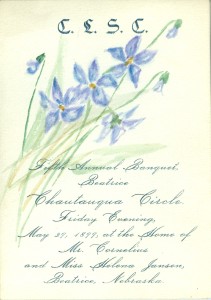Before automobiles and radios made the world a smaller place, it could be challenging for adults in rural areas to gain access to the kinds of cultural and educational opportunities that were common in large cities. The solution was the Chautauqua movement, which began in New York in the 1870s. By the 1880s, inter-state Chautauqua assemblies had reached Nebraska, bringing lectures, music, and other cultural programs.
In 1894 several men and women of Beatrice, Nebraska, founded the Beatrice Chautauqua Circle, later known as the Beatrice Chautauqua Literary and Scientific Circle (C.L.S.C.). According to the organization’s constitution, their goal was “. . . to promote habits of reading and study in history, literature, science and art, to give college graduates a review of the college course, to secure for those whose educational privileges are limited the college graduate’s general outlook upon the world and life and to encourage close, connected, persistent thinking.”
This was not a casual group of people getting together to socialize. Their organization maintained strict membership rules, elected officials, acquired textbooks, studied together, and organized an array of learning programs, including lectures, musical solos and duets, discussions, readings, vesper services, and an annual banquet. They even organized themselves into graduating classes, like a university. This was an outlet for people with a strong desire for education and scholarly activity.
Yet the organization was small enough that the programs for the 1899 annual banquet featured hand-painted watercolor pictures, featuring six different designs representing the emblems of the six classes. Shown here is the violet of the 1898 class.
The Nebraska State Historical Society has a small collection of materials from the Beatrice Chautauqua Literary and Scientific Circle, including three volumes of their meeting minutes and a sampling of their event programs. See the NSHS website for a complete finding aid for the Beatrice Chautauqua Literary and Scientific Circle collection.
Angela Kroeger
NSHS Practicum Student





